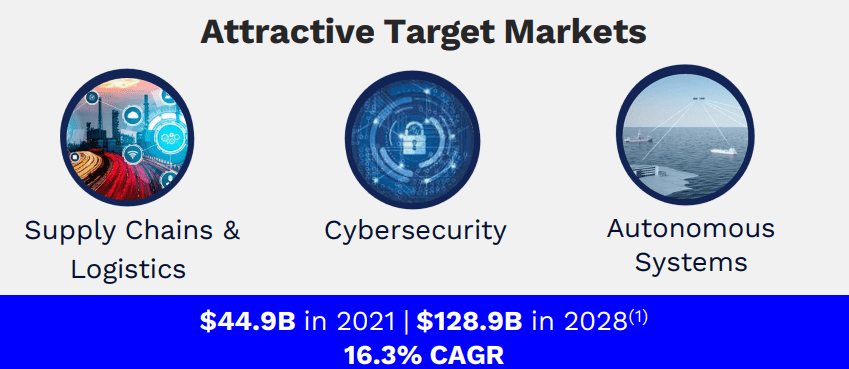Is D-Wave Quantum (QBTS) A Smart Quantum Computing Investment? Pros And Cons

Table of Contents
Quantum computing represents a technological revolution, promising to solve problems currently intractable for even the most powerful classical computers. Applications range from drug discovery and materials science to financial modeling and artificial intelligence. D-Wave Quantum (QBTS) distinguishes itself through its focus on quantum annealing, a unique approach to solving optimization problems. While not a general-purpose quantum computer like gate-based models, quantum annealing offers advantages in specific applications. This article will delve into whether this approach translates to a smart investment in QBTS stock.
Pros of Investing in D-Wave Quantum (QBTS)
First-Mover Advantage
D-Wave's early entry into the quantum computing market provides a substantial first-mover advantage. This translates into:
- Established infrastructure: Years of research and development have resulted in a robust infrastructure, including highly specialized hardware and software.
- Extensive patent portfolio: A strong intellectual property portfolio protects D-Wave's innovations and provides a competitive edge.
- Early adoption by key clients: Major corporations and research institutions have already adopted D-Wave's technology, providing valuable real-world testing and feedback.
This early adoption showcases D-Wave's technology's practicality in tackling real-world optimization problems. While facing competition from companies developing gate-based quantum computers like IBM and Google, D-Wave occupies a unique niche, focusing on specific applications where quantum annealing excels. Partnerships with organizations like Volkswagen and Los Alamos National Laboratory solidify D-Wave's position as a key player in the quantum computing ecosystem.
Strong Partnerships and Client Base
D-Wave boasts an impressive roster of partners and clients, including:
- Volkswagen: Collaborating on traffic optimization and logistics solutions.
- Los Alamos National Laboratory: Partnering on research and development in various scientific fields.
- NEC: A strategic partnership focusing on advancing quantum computing technology and applications.
These partnerships validate D-Wave's technology and provide access to valuable resources and expertise. Significant contracts with these organizations demonstrate a growing demand for D-Wave's quantum annealing solutions, suggesting a strong revenue stream and potential for future growth. The continued expansion of its client base strengthens the case for QBTS as a viable investment.
Potential for High Returns
The quantum computing market is poised for explosive growth. Analysts predict significant expansion in the coming years, offering D-Wave the opportunity to capture substantial market share.
- Projected market growth: Industry projections suggest a multi-billion dollar quantum computing market within the next decade.
- D-Wave's potential market share: D-Wave's first-mover advantage and strong partnerships position them well to benefit from this growth.
- Risk factors influencing potential returns: While the potential for high returns is significant, the quantum computing market remains volatile, and success is not guaranteed. Careful analysis of QBTS stock valuation is crucial.
Cons of Investing in D-Wave Quantum (QBTS)
Technological Limitations
Quantum annealing, D-Wave's approach, has limitations compared to gate-based quantum computing:
- Specialized applications: Quantum annealing is particularly well-suited for optimization problems but less versatile than gate-based approaches.
- Scalability challenges: Scaling up quantum annealers to tackle increasingly complex problems remains a significant hurdle.
- Limited algorithm applicability: Not all computational problems can benefit from quantum annealing.
Understanding these limitations is crucial. While D-Wave's technology offers significant advantages in specific areas, investors should be aware of its limitations compared to more general-purpose quantum computing architectures.
Financial Risks
Assessing the financial health of QBTS is crucial for any investment decision:
- Profitability: Currently, D-Wave is not yet profitable, relying heavily on funding and partnerships.
- Debt levels and cash flow: Analyzing the company's debt levels and cash flow will help assess its financial stability and risk profile.
- Competitor activity: Intense competition from other quantum computing companies adds to the financial risks.
A thorough examination of QBTS's financial statements is essential before investing. The nascent nature of the quantum computing market introduces inherent financial instability.
Market Volatility
The quantum computing market's immaturity contributes to significant volatility:
- Unpredictable market fluctuations: The relatively young market is susceptible to dramatic price swings.
- Long-term investment horizon: Investing in QBTS necessitates a long-term perspective due to the inherent market volatility.
- Impact of macroeconomic factors: Broad economic conditions can significantly impact QBTS stock performance.
Conclusion: Is D-Wave Quantum (QBTS) Right for Your Portfolio?
Investing in D-Wave Quantum (QBTS) presents a compelling but risky proposition. While the company enjoys a first-mover advantage, strong partnerships, and the potential for significant returns in a rapidly growing market, it faces technological limitations, financial risks, and market volatility. This analysis aimed to provide a balanced perspective, highlighting both the potential rewards and inherent uncertainties. Before investing in QBTS stock or any quantum computing venture, thorough due diligence is essential. Consider your risk tolerance, investment horizon, and diversify your portfolio accordingly. Is D-Wave Quantum (QBTS) the right quantum computing investment for you? Conduct further research into QBTS stock and the broader quantum computing market to arrive at an informed decision.

Featured Posts
-
 Un Restaurant Au Sommet Des Galeries Lafayette Biarritz Avant Celui De Pau Rencontre Avec Imanol Harinordoquy Et Jean Michel Suhubiette
May 20, 2025
Un Restaurant Au Sommet Des Galeries Lafayette Biarritz Avant Celui De Pau Rencontre Avec Imanol Harinordoquy Et Jean Michel Suhubiette
May 20, 2025 -
 Gross Law Firm Representing Investors In Big Bear Ai Bbai Stock
May 20, 2025
Gross Law Firm Representing Investors In Big Bear Ai Bbai Stock
May 20, 2025 -
 Trumps Aerospace Deals A Closer Look At The Numbers And Missing Details
May 20, 2025
Trumps Aerospace Deals A Closer Look At The Numbers And Missing Details
May 20, 2025 -
 O Noua Generatie In Familia Schumacher Prima Poza Cu Nepotelul
May 20, 2025
O Noua Generatie In Familia Schumacher Prima Poza Cu Nepotelul
May 20, 2025 -
 Agatha Christies Poirot A Critical Analysis Of The Stories
May 20, 2025
Agatha Christies Poirot A Critical Analysis Of The Stories
May 20, 2025
